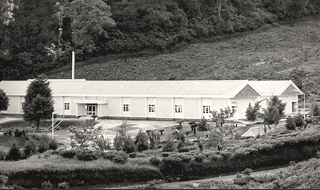Eisai was now achieving unprecedented rapid growth. During this time, on May 14, 1966, Yuji Naito was entrusted with taking the helm as Eisai's new president.
In the years that followed, Japan enjoyed a period of high economic development and internationalization and Eisai was able to establish a nationwide distribution network based on branches in 12 locations: Sendai, Tachikawa, Yokohama, Shizuoka, Kanazawa, Kyoto, Kobe, Wakayama, Okayama, Hiroshima, Takamatsu and Kumamoto. Furthermore, continuing down its path of development and infrastructure enhancement, which was already off to a promising start with the company reaching its annual sales target of US$100 million (¥36 billion) three years ahead of schedule in 1971, Eisai was soon able to move ahead with its plans for overseas expansion as well. With its global strategy now moving into full swing, Eisai also changed its corporate logo from its Roman-and-Japanese, two-script design to a more globally recognizable logo that unified the name to “Eisai” displayed in black, Roman letters.















